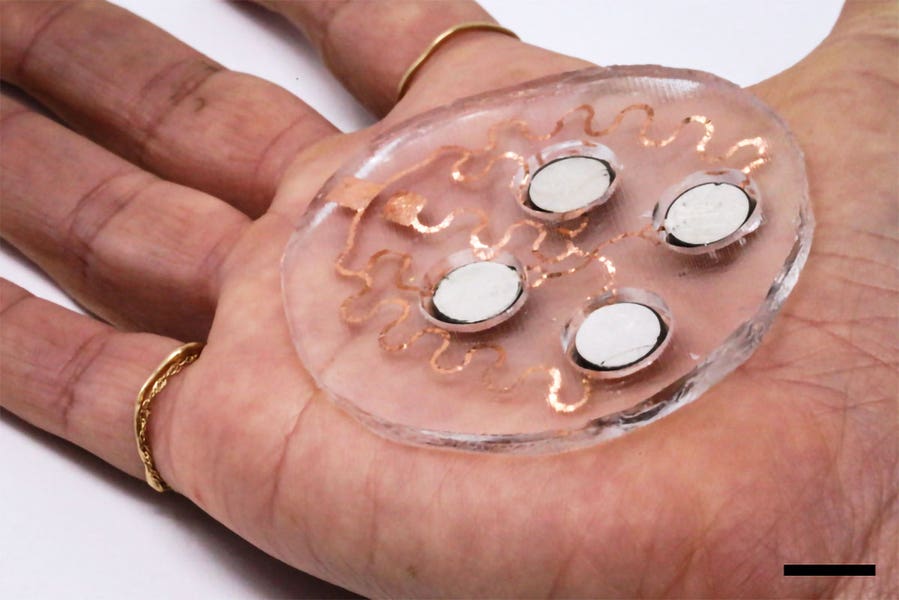Groundbreaking wearable patch painlessly delivers drugs through the skin
Using ultrasonic waves that propel drug molecules into the skin, the patch could be used to treat a variety of skin conditions.

[Apr. 22, 2023: JJ Shavit, The Brighter Side of News]
MIT researchers have developed a wearable patch that applies painless ultrasonic waves to the skin, creating tiny channels that drugs can pass through. (CREDIT; MIT Researchers)
MIT researchers have developed a wearable patch that uses ultrasonic waves to deliver drugs through the skin. The device creates tiny channels that allow drugs to be delivered directly to the site where they are needed. The researchers hope this approach could be used to deliver treatments for a variety of skin conditions, as well as other drugs like hormones and muscle relaxants.
The patch is made of PDMS, a silicone-based polymer that can adhere to the skin without tape. In tests using pig skin, the researchers showed that when they delivered niacinamide using the ultrasound patch, the amount of drug that penetrated the skin was 26 times greater than the amount that could pass through the skin without ultrasonic assistance.
The skin is an attractive route for drug delivery because it offers a direct path to the site where drugs are needed, which is useful for wound healing, pain relief, and other medical and cosmetic applications. However, delivering drugs through the skin is difficult because the tough outer layer of the skin prevents most small molecules from passing through it. MIT researchers hope that their new wearable patch could make it easier to deliver drugs through the skin, and they are working to optimize the device for human trials.
The researchers began this project as an exploration of alternative ways to deliver drugs. Most drugs are delivered orally or intravenously, but the skin is a route that could offer much more targeted drug delivery for certain applications. “The main benefit with skin is that you bypass the whole gastrointestinal tract. With oral delivery, you have to deliver a much larger dose in order to account for the loss that you would have in the gastric system,” says Aastha Shah, a lead author of the paper.
Related Stories
Ultrasound exposure has been shown to enhance the skin’s permeability to small-molecule drugs, but most of the existing techniques for performing this kind of drug delivery require bulky equipment. The MIT team wanted to come up with a way to perform this kind of transdermal drug delivery with a lightweight, wearable patch, which could make it easier to use for a variety of applications.
The wearable patch consists of a patch embedded with several disc-shaped piezoelectric transducers, which can convert electric currents into mechanical energy. Each disc is embedded in a polymeric cavity that contains the drug molecules dissolved in a liquid solution. When an electric current is applied to the piezoelectric elements, they generate pressure waves in the fluid, creating bubbles that burst against the skin. These bursting bubbles produce microjets of fluid that can penetrate through the skin’s tough outer layer, the stratum corneum.
“The ease-of-use and high-repeatability offered by this system provides a game-changing alternative to patients and consumers suffering from skin conditions and premature skin aging,” says Canan Dagdeviren, an associate professor in MIT’s Media Lab and the senior author of the study. “Delivering drugs this way could offer less systemic toxicity and is more local, comfortable, and controllable.”
In tests using pig skin, the researchers showed that when they delivered niacinamide using the ultrasound patch, the amount of drug that penetrated the skin was 26 times greater than the amount that could pass through the skin without ultrasonic assistance.
The researchers also compared the results from their new device to microneedling, a technique sometimes used for transdermal drug delivery, which involves puncturing the skin with miniature needles. The researchers found that their patch was able to deliver the same amount of niacinamide in 30 minutes that could be delivered with microneedles over a six-hour period.
With the current version of the device, drugs can penetrate a few millimeters into the skin, making this approach potentially useful for drugs that act locally within the skin. These could include niacinamide or vitamin C, which is used to treat age spots or other dark spots on the skin, or topical drugs used to heal burns.
The patch is made of PDMS, a silicone-based polymer that can adhere to the skin without tape. The patch is embedded with several disc-shaped piezoelectric transducers, pictured. (CREDIT: MIT)
The researchers are optimistic that their ultrasonic patch technology can be used in a wide range of applications, including cosmetic treatments, pain management, and wound healing. They are currently testing the device with a variety of other drugs, including lidocaine and caffeine.
According to Chia-Chen Yu, one of the lead authors of the study, "We are really excited about the potential of this technology. It has the potential to revolutionize the way we deliver drugs through the skin, and could open up new avenues for treating a wide range of medical conditions."
The team is currently working on optimizing the wearable patch and hopes to test it soon on human volunteers. They also plan to repeat the lab experiments they did in this study, with larger drug molecules.
Device concept. Photograph of the 2D-array of conformable ultrasound patch (cUSP) (diameter 5 cm, thickness 2 mm) attached to a curvilinear glass cylinder;scale bar: 1 cm. (CREDIT: Advanced Materials)
"By characterizing the drug penetration profiles for much larger drugs, we can see which candidates, like hormones or insulin, can be delivered using this technology, to provide a painless alternative for those who are currently bound to self-administer injections on a daily basis," says Aastha Shah, the other lead author of the study.
The researchers are also exploring the possibility of implanting similar devices inside the body to deliver drugs to treat cancer or other diseases. The ultrasonic patch technology could potentially be used to target specific areas of the body with cancer drugs, without the need for invasive procedures or chemotherapy.
Overall, the ultrasonic patch technology developed by the MIT researchers is a promising new approach to drug delivery through the skin. With its potential to deliver drugs locally and painlessly, the technology could revolutionize the way we treat a wide range of medical conditions, from skin conditions to cancer.
Note: Materials provided above by The Brighter Side of News. Content may be edited for style and length.
Like these kind of feel good stories? Get the Brighter Side of News' newsletter.



